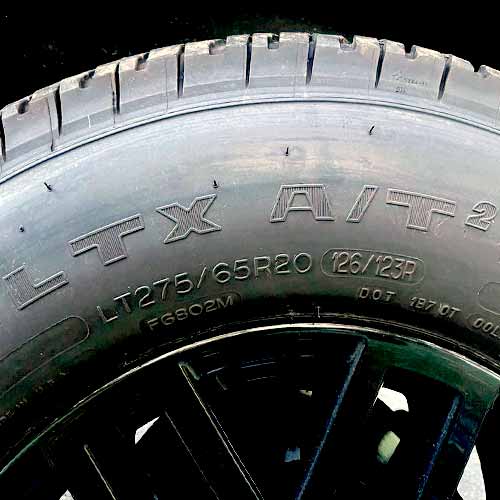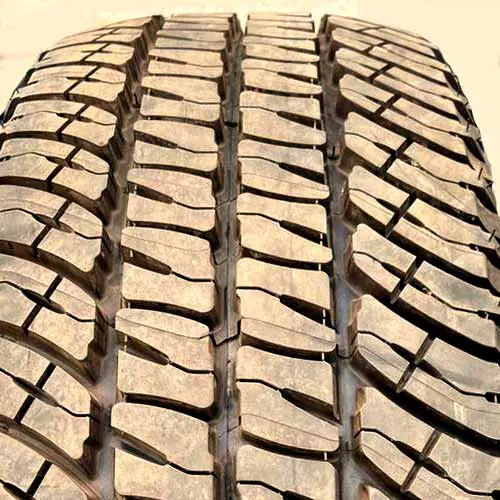Michelin LTX A/T2 used in mostly light trucks, SUVs, and Jeeps. You can say it’s a mild all terrain tire, which can probably tell by looking at it’s sidewalls, it provides no biters there, so airing down won’t have too much of an impact, but the tire is still capable of a few things. Let’s check them out!

Being a tire engineer, from my perspective, the Michelin LTX A/T2 offers a great dry traction where it’s directional grip takes away a larger part. The tire is also pretty great in the comfort department as well as tread life, though it badly needs wet traction, and it consumes a lot of fuel as well. Off road things are not so bad, where the only place to worry about is wet, so on mud, wet grass, wet rocks, and so on, you are not going to get much grip. But in dry conditions the tire does okay where it’s great in climbing on rocks and sand.
Table of Contents
Tire sizes
Michelin LTX A/T2 gives you 15 to 20 inches wheel diameter sizes.
But there are very limited sizes overall, just 20.
These sizes offer a weight range of 32 lbs to 60 lbs (where the 235/75R15 is the lightest, while 275/65R20 is the heaviest).
This is because the sizes load ratings vary between SL, XL, C, D and E.
And as for the speed ratings, they lie in R, S and T only.
Tread depth of all sizes are seen with mostly 14/32″ and 17/32″, where a few get to have even lower than that.
The tire offers 500 A B of UTQG rating, so it’s tread wear is average for an all-terrain tire, though Michelin gives 60k miles warranty with it.
Tread Design
The Michelin LTX AT2 offers a pretty unique design with 4 columns of ribs.

Lets take things form shoulders. Here the lugs have prominent X shaped notches which are joined by rectilinear siping.
The whole shoulder rib is joined together form underneath, so you can say it makes a continuous design.
Same goes for the rest of the ribs as well (this design basically provides better on road stability).
The inner ribs are smaller, and make same groove notches and siping patter.
All these offer a great off road bite, worth noticing, but as aggressive the tire is in the middle, it does not offer aggressive enough sidewall lugs.
Sidewall lugs are very important for off road traction, as you’ll see in it’s off road performance.
They come in to action mostly, when the tire’s pressure is lowered down.
Internally, the tire offers a very average make-up of 2 ply polyester casing (very common with A/T tires), which has 2 layers of steel belts on top and 2 more layers of nylon.
The cap plies don’t cover the sidewalls, so the Michelin AT2 only has 2 ply sides, without any lugs on top, protecting the weakest part of the tire. So you can say durability wise, the tire is just average.
Compare Michelin LTX A/T2 With Others
- Firestone Destination AT2
- Hankook Dynapro AT2
- Hankook Dynapro ATM
- Cooper Discoverer AT3
- Michelin Defender LTX MS
On Road Performance
When it comes to all terrain tires, they are not expected to perform too great here. That’s because precise steering, dynamic grip including lateral traction involves smooth tires, and A/T tires compromise with their larger grooves.
But how is our tire in these factors, on both dry and wet conditions? Well, lets check it out.
Dry Traction
Dry grip tells you about directional traction and here the middle part of the tread is judged, whereas, for the handling, or say lateral traction, shoulders are considered.
Both grip values combined tell you about the dry traction overall.
Michelin LTX AT2 offers a softer rubber with a lot of notches and biters everywhere, so grip wise, that’s not an issue, you get plenty.
Same goes for lateral traction where the plus shaped tread voids bite in to the surface from all directions, offering a good overall mixture of lateral traction, which results in handling efficiency.
Wet Traction
Wet roads are different, here you need fast water removal, as water is not compressible, so in order to do that, the tire’s are embedded with grooves and sipes which determine grip and hydroplaning.
The wet grip of a tire has very much to do with tire’s make up and number (and design) of sipes.
Michelin LTX A/T2 although offers a high silica compound (of its rubber), allowing sipes to be flexible, there aren’t too many sipes to begin with.
While cornering the sides of the tire are in charge, and here the shoulder lugs (if you scroll up to check out it’s tread design), you’ll see it has very less siping in that area.
The wet traction is further lost with in-optimized design of these sipes, as they are not interlocking enough. So on sharp turns, these sipes get hardened up and lose water wiping abilities.
Nonetheless, the tire is capable of offering directional grip, as the notches and sipes of the tread in the middle remain soft with braking (as they don’t cause rigidity in these sipes).
But overall it’s performance here is not impressive, and here hydroplaning contributes a lot as well.
Hydroplaning has to do with water evacuation, the more the water gets removed out of the tire the better the hydroplaning/aquaplaning resistance.
Michelin LTX AT2 as I explained in the tread section, basically forms a continuous ribs, all 4 of them, so water can although leave the tire longitudinally, there is no sideways evacuation.
That’s the reason why this tire is not good at curved aquaplaning, but does okay on straight paths.
So it’s also another reason why the handling of this tire on wet roads is so limited, as with faster water removal less is there for sipes to work on.
Snow Performance
Winter performance has very different terrain challenges, there’s ice, where need a lot of biters, there’s deep snow, where you need deeper tread voids and then there’s most common, on road snow.
Now the Michelin AT2 although is not 3 peak mountain snowflake rated, the tire is surprisingly not so bad in this area.
The multiple notches everywhere offer a pretty decent grip, where all these notches tend to stay flexible even with extreme negative temperatures.
But remember that the tire does things great only when it comes to braking and acceleration (compared to other A/T tires without winter ratings), as these tires are very prone to slide sideways on snow and ice.
Ride Comfort
The ride comfort has 2 parts, noise and well, comfort.
Noise is tread noise and here tire’s baldness has a huge roll to play. The balder the tire, the noisier the tire, as noise is just air and air hits with more forces inside larger grooves.
The good thing about Michelin LTX AT2 is that it’s ribs are continuous and there is no lateral gaps in between, meaning air has a hard time to get in to the tire and hit the tread. So overall noise is pretty dampened. (Overall the tire is as quite as the Cooper AT3 (review) to give you an idea).
For the comfort part, the tire is again above average. It’s 2 cap plies of nylon are pretty soft and the tread on top with the depth of 17/32″ (max), is enough for vibrations of the road to settle down.
To put in another way, thicker the tread, the more area for the bumps to diminish, and 17/32″ is pretty enough for that.
For your info: Falken Wildpeak at3w offers deepest tread in the category (review).
Fuel And Tread Usage
Both fuel and tread are influenced by rolling resistance which is calculated by looking at the tread’s structure/composition and tire’s weight.
And the Michelin AT2 does not offer impressive performance here.
It basically has a softer rubber and a lot of notches on top, a recipe for getting high rolling resistance, which means higher fuel consumption.
But still the tread wear is still kept at a minimum as the tire gets to have a decent tread depth and dual compound of rubber, where the layer underneath is slightly harder.
That’s why you get 60k miles warranty as well.
Off Road Traction
The Michelin AT2 is the only all terrain tire that the company makes, and the tire is okay considering its meant to be used mostly for pavements.
Let’s check out how it performed on different areas.
Gravel and Dirt
Though the tire does not offer any kind of stone ejectors. It’s still pretty solid of gravely roads, as it’s flexible tread does not invite a lot of stones to settle in.
Moreover, it’s cut resistant rubber further improves things, as you can run this tire at higher speeds there without worrying about it’s wear.
Rock Climbing
The Michelin LTX AT2 is a good tire for rock climbing (compared to other on-road oriented all-terrain tires) like Vredestein Pinza AT (review) to give you an example.
The tire offers pretty decent grip (where it’s directional grip is the one to look for). And with this, combined with lighter overall construction, you get a good climber.
Though with this tire, you do feel the need of sidewall lugs, which could have helped this tire a lot in lateral traction area as well.
Sand
The Michelin LTX AT2 is not a heavier tire, and it’s softer tread yields ample tread print, so it’s slightly above average for sandy terrains.
And although the tire does not provide sidewall lugs which could have improved tread print further (with lowered air pressure), the elongated lugs still provide decent enough paddling aid.
Mud
On mud you need a self cleaning tire.
And let me tell you the Michelin LTX AT2 is a bad choice here, as it lacks a lot in keeping it’s tread clear off mud.
Basically, this tire only has longitudinal grooves which although offer mud to leave out vertically, there is no place to go sideways.
Meaning all ribs are made continuous and there are no proper lateral gaps where mud can leave out.
And to top that, the tire lacks in traction scoops and efficient wet traction, so mud traction becomes a disaster with this tire.
Conclusion
Michelin LTX AT2 is a good all rounder tire which is great on roads, very quite, fuel economic, and offering decent tread life.
The tire although does not offer 3 peak mountain snowflake rating, still does pretty good on snowy terrains, where its softer rubber stays flexible with freezing temperatures.
The downsides with this tire is wet, no matter where you are, on road, grass, mud, rocks, if it’s wet, you are going to loose traction.